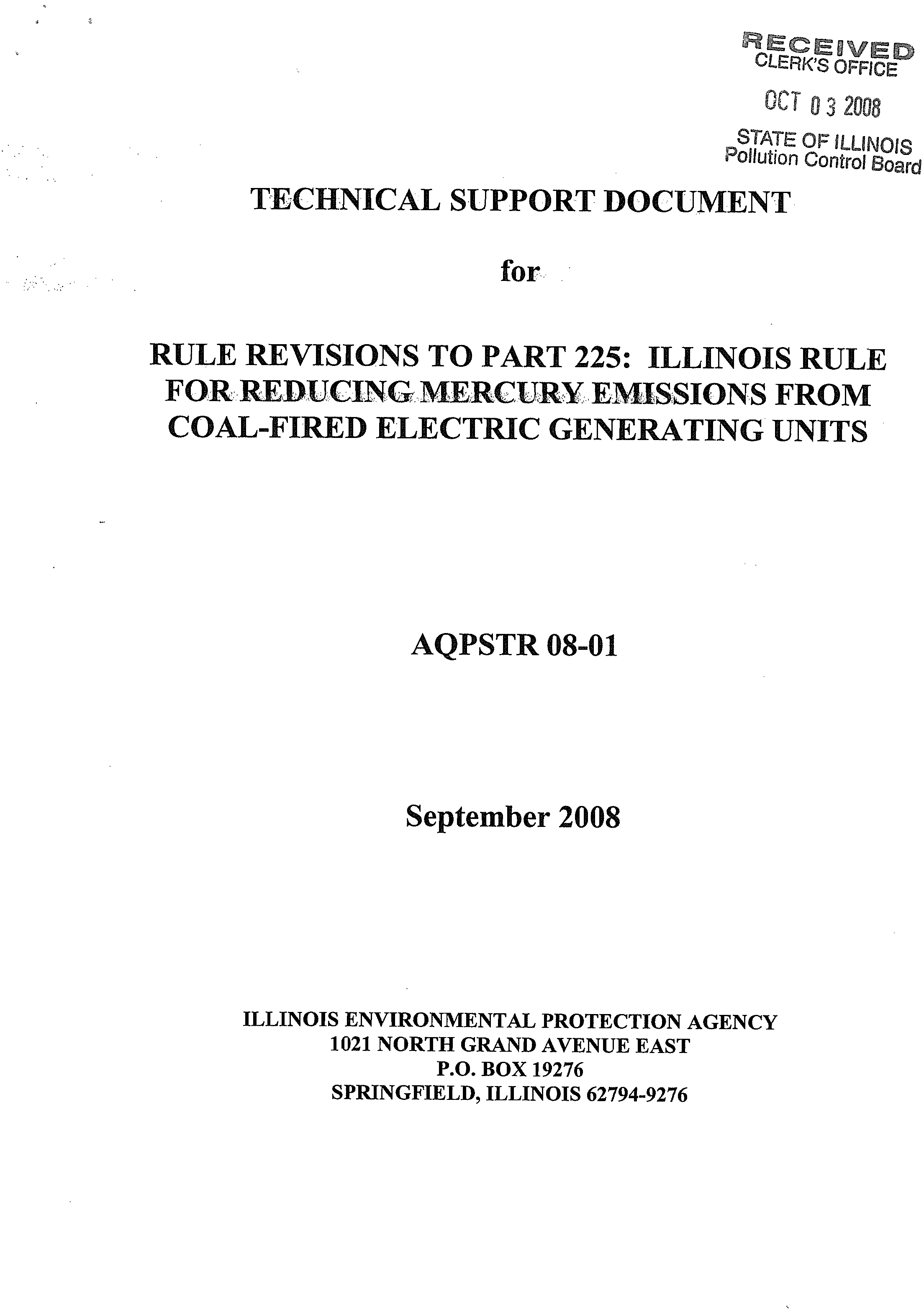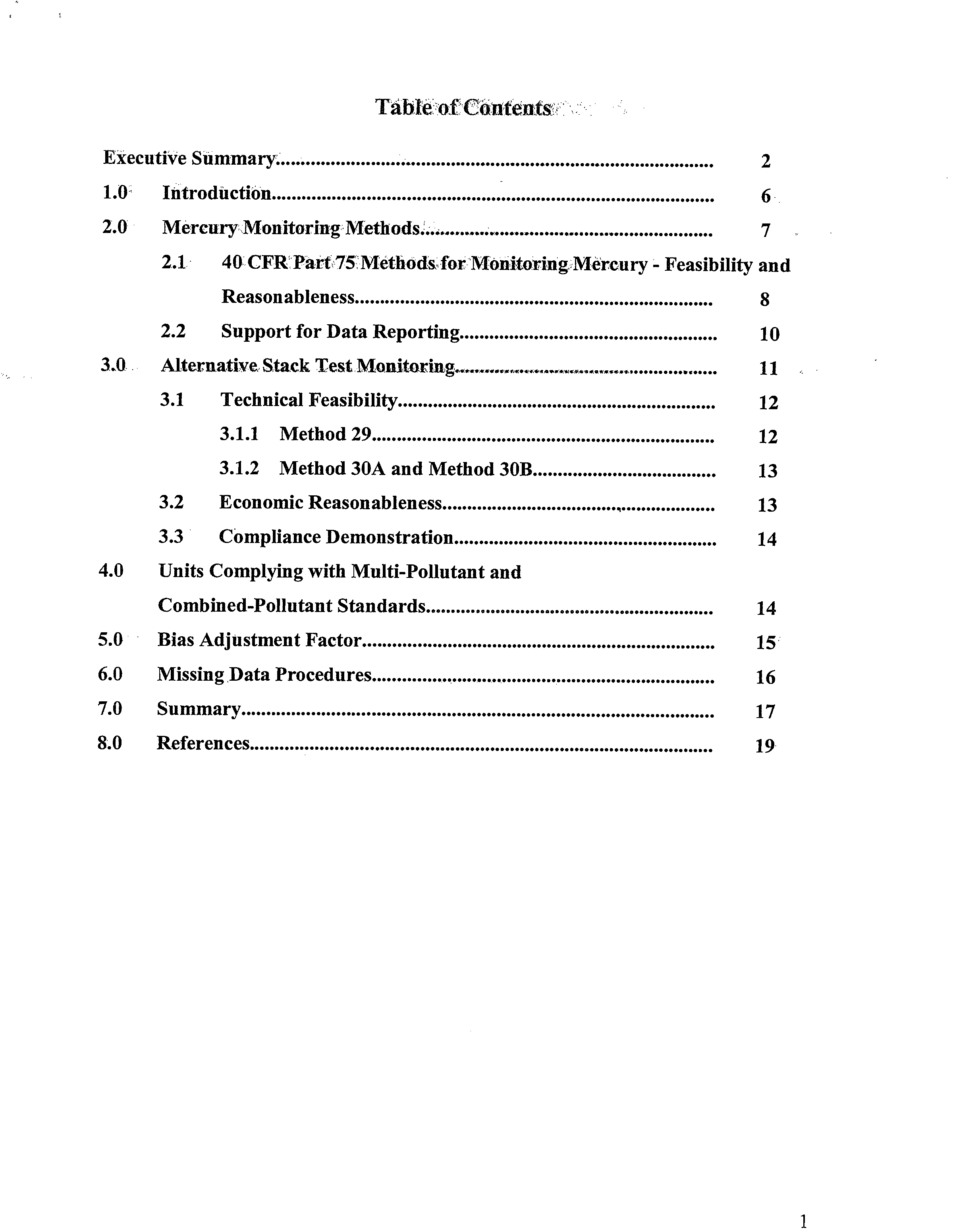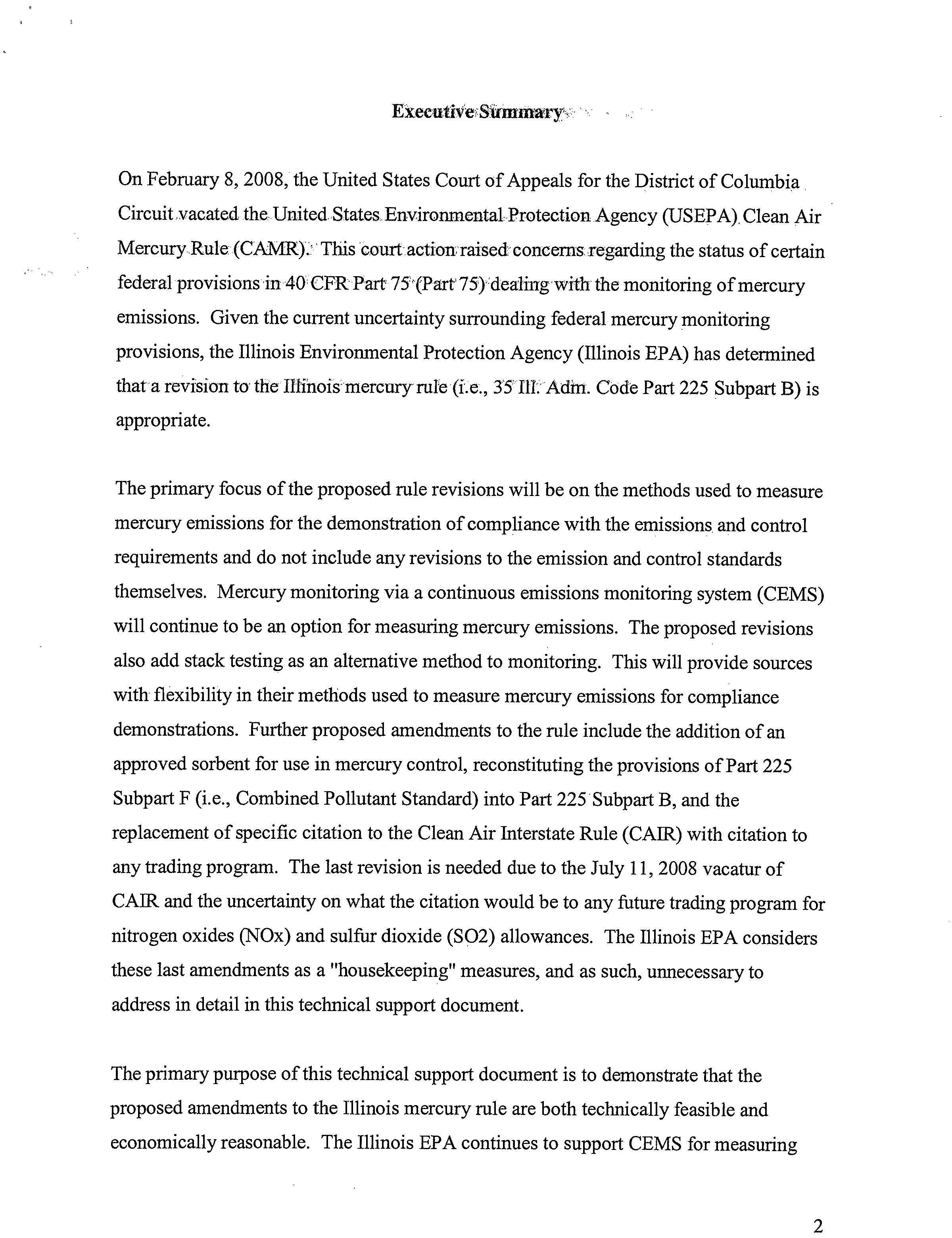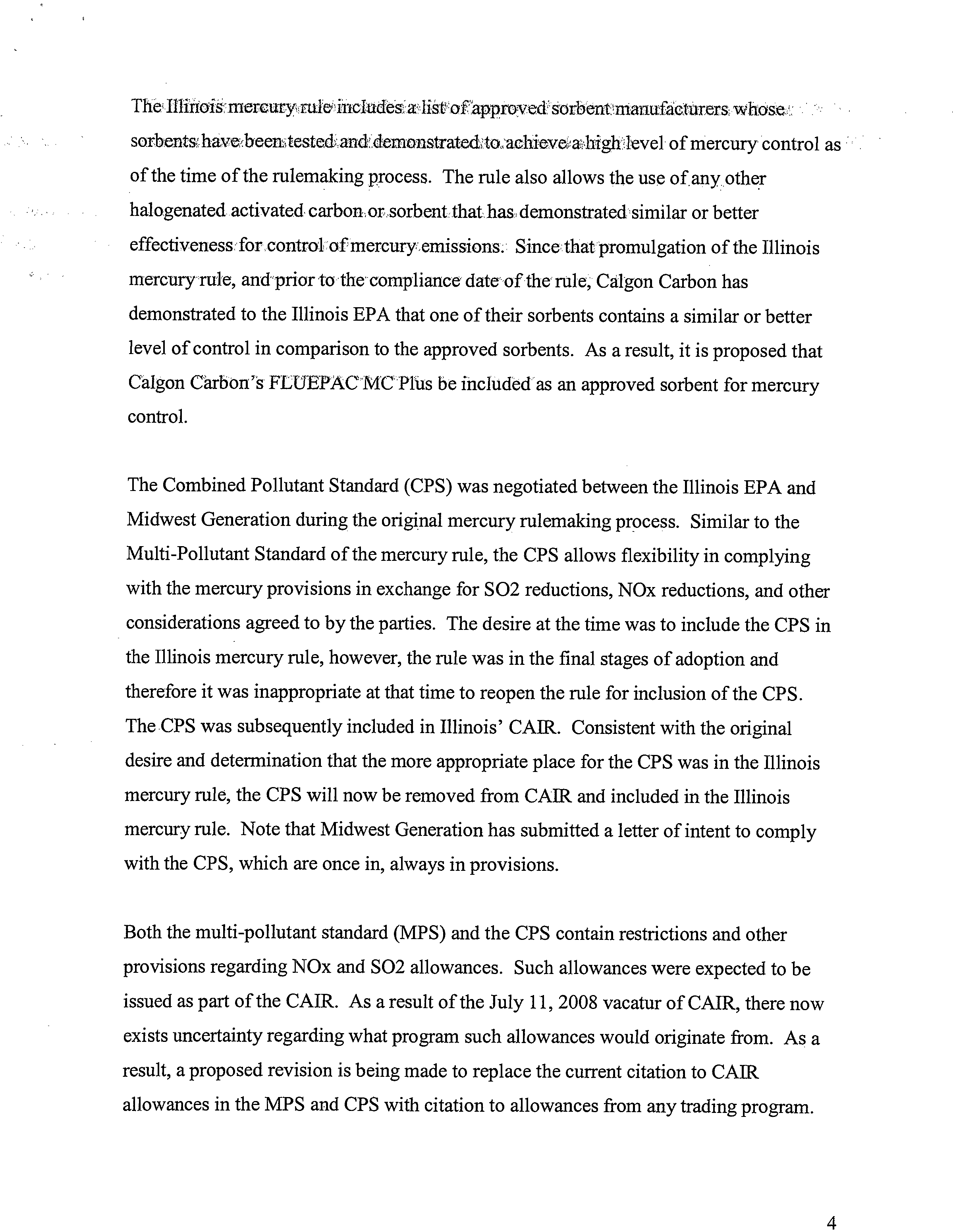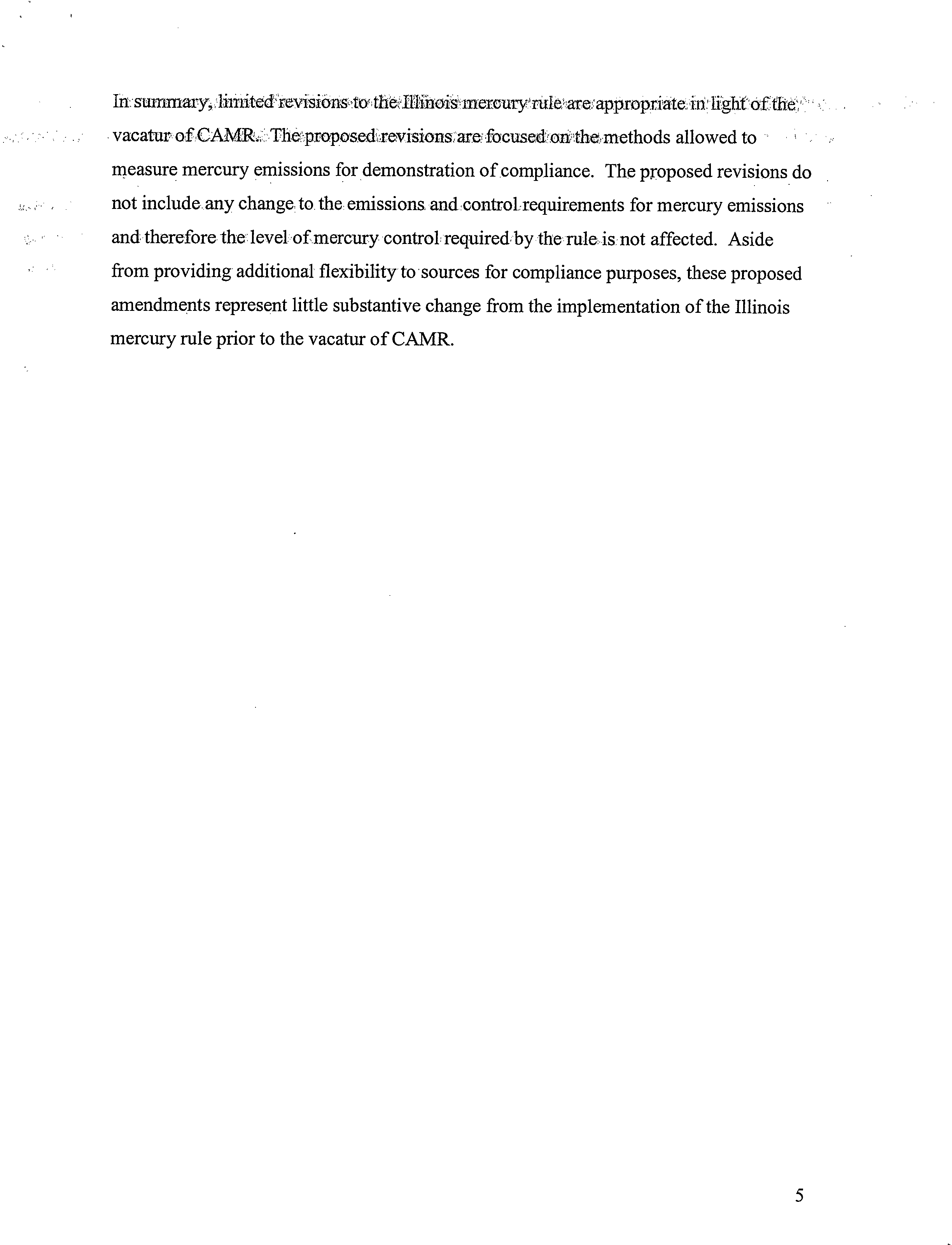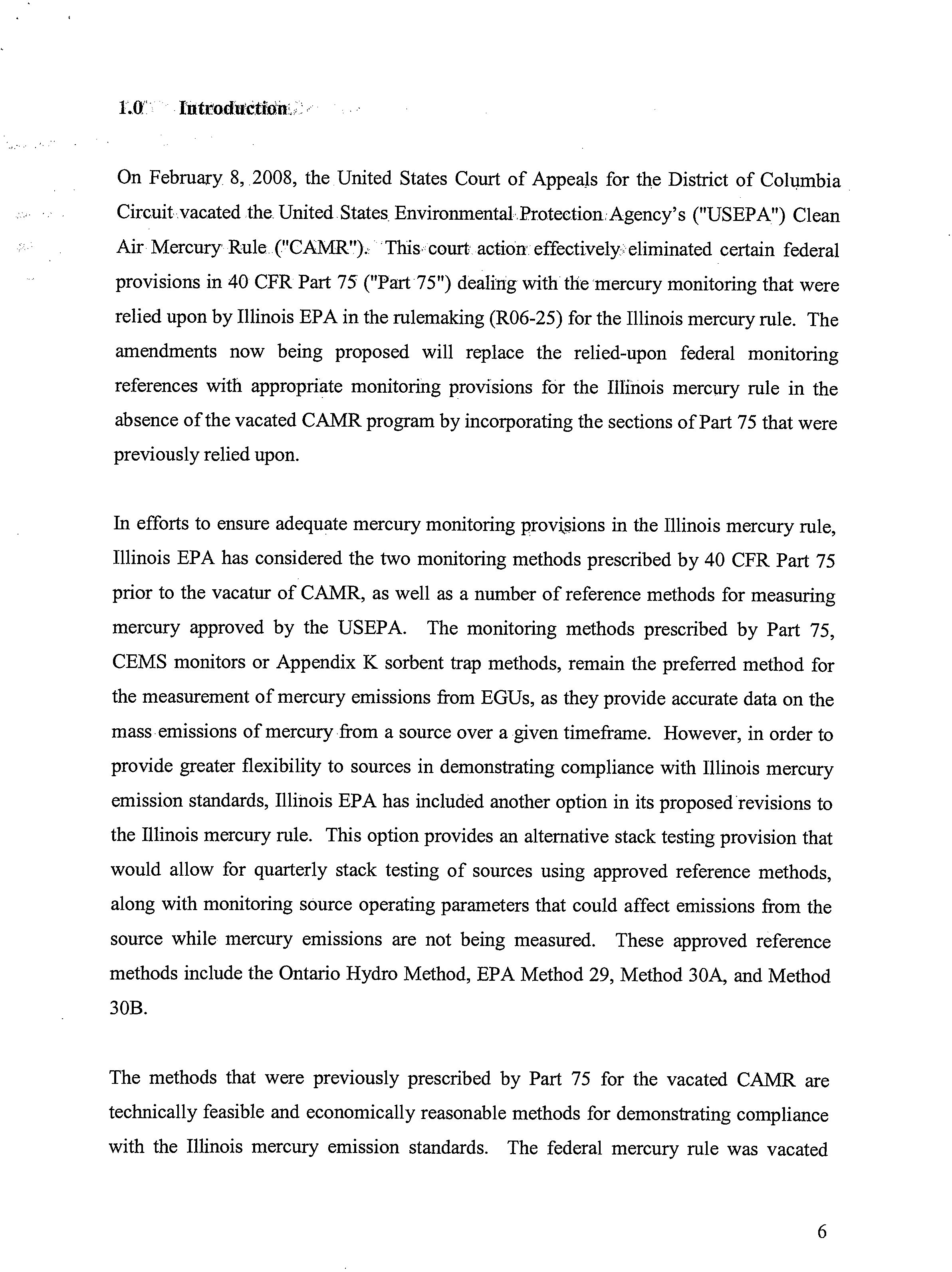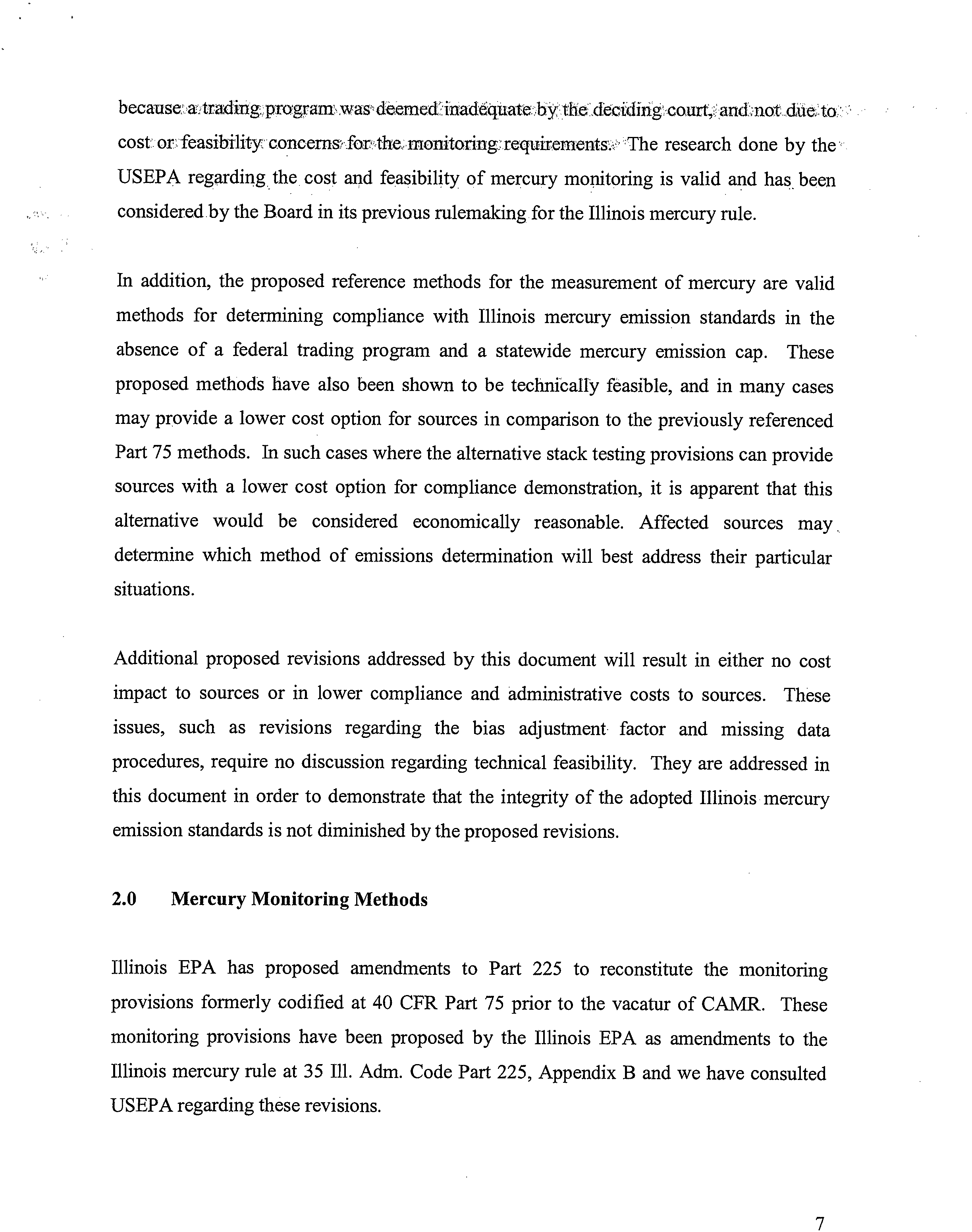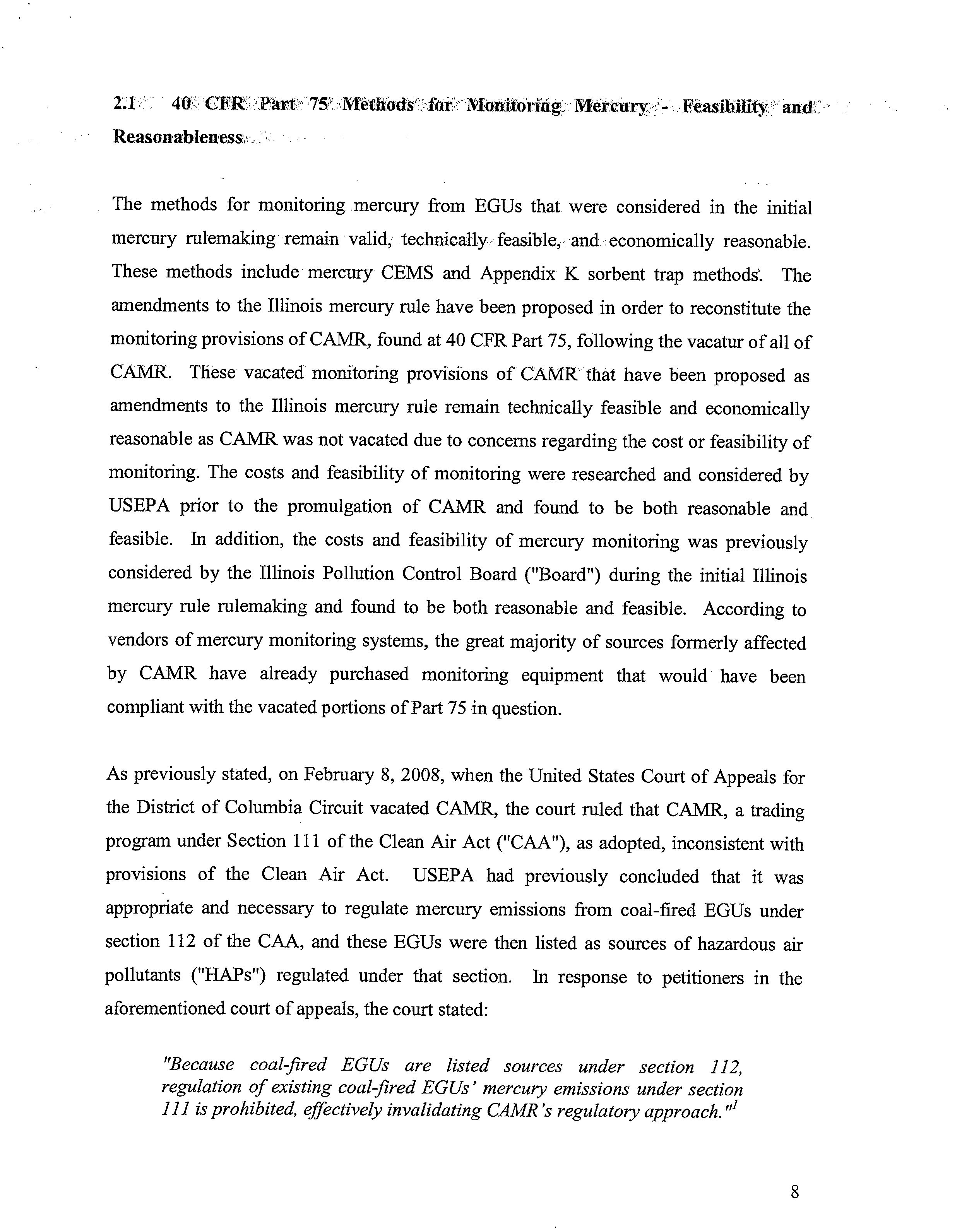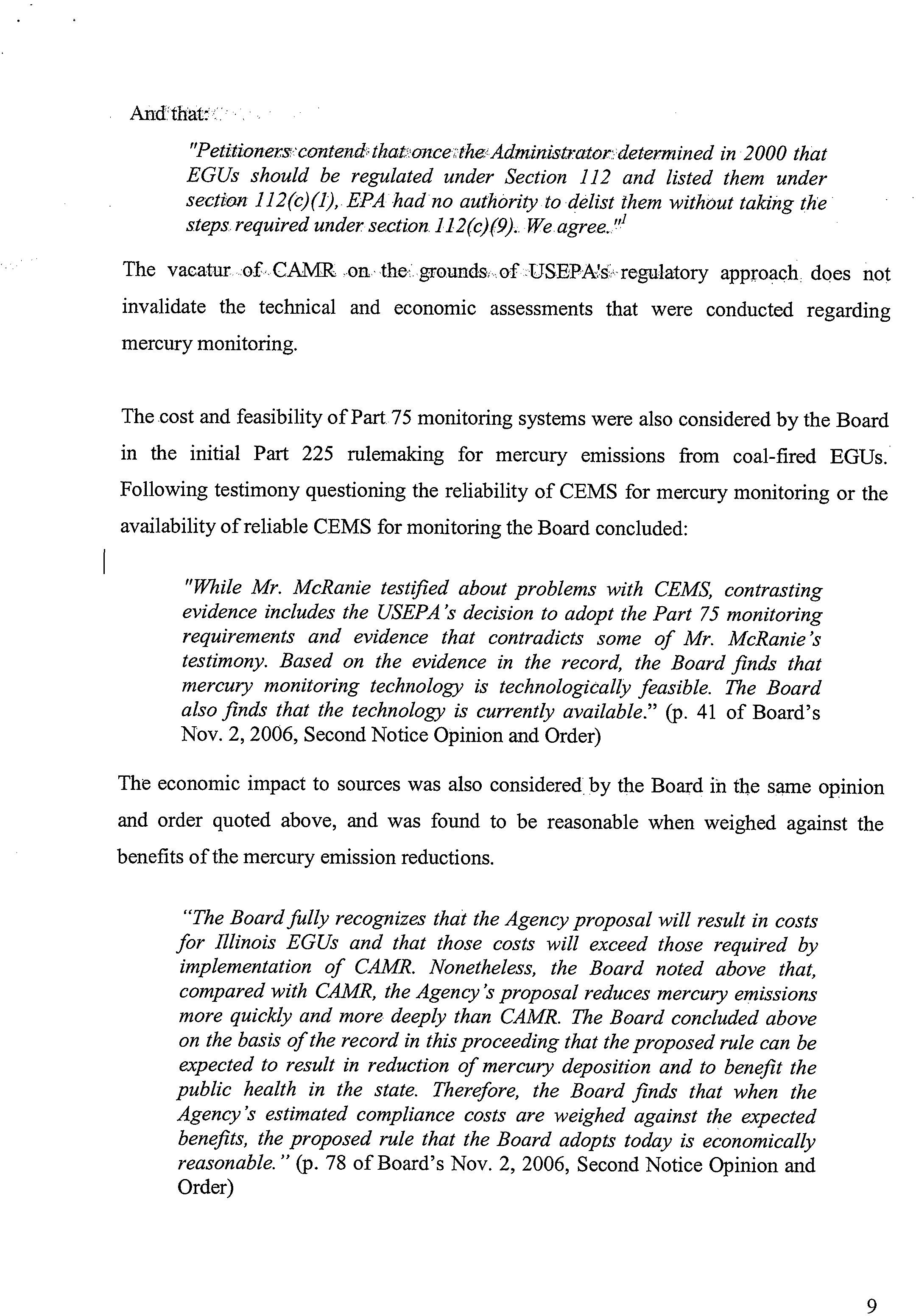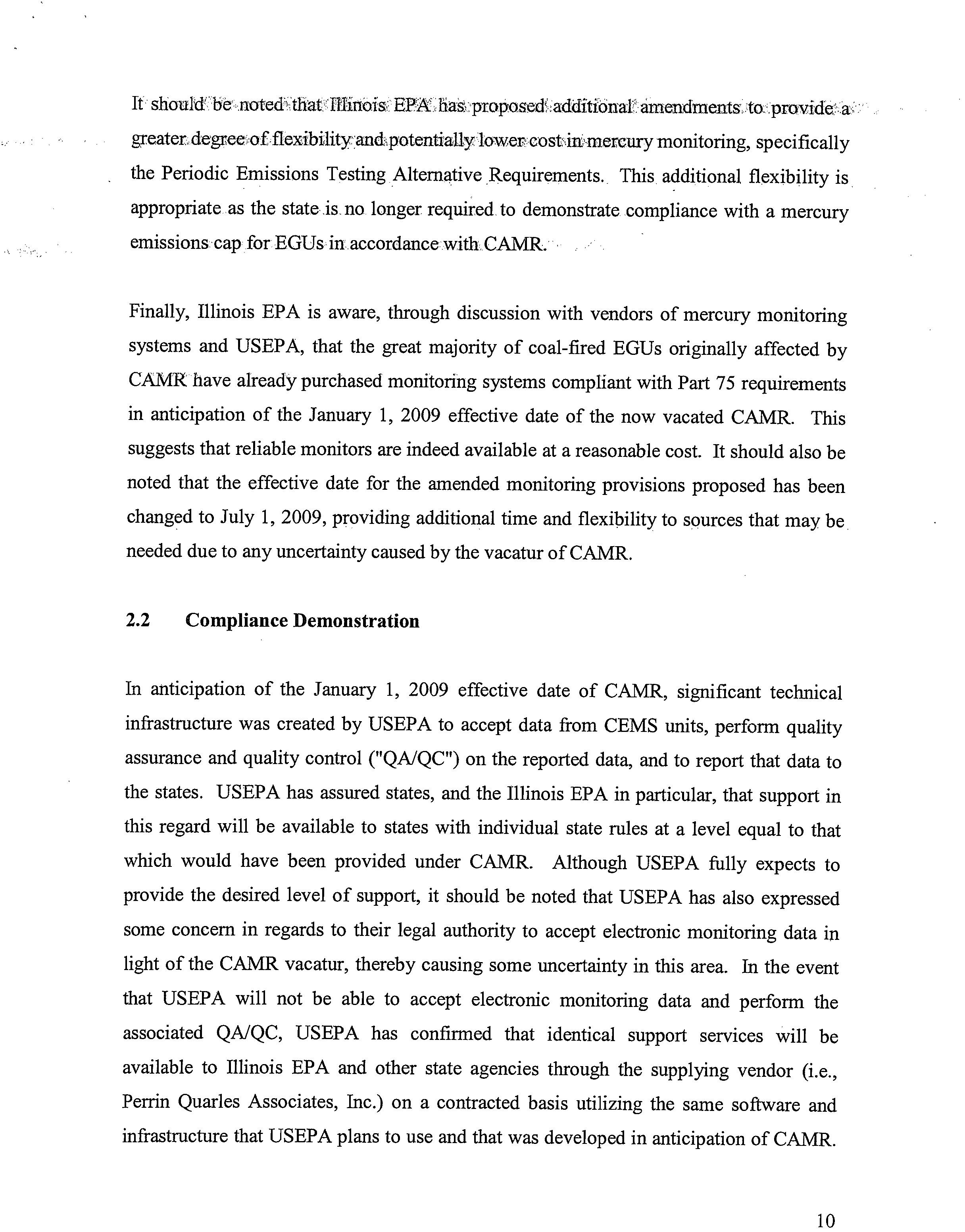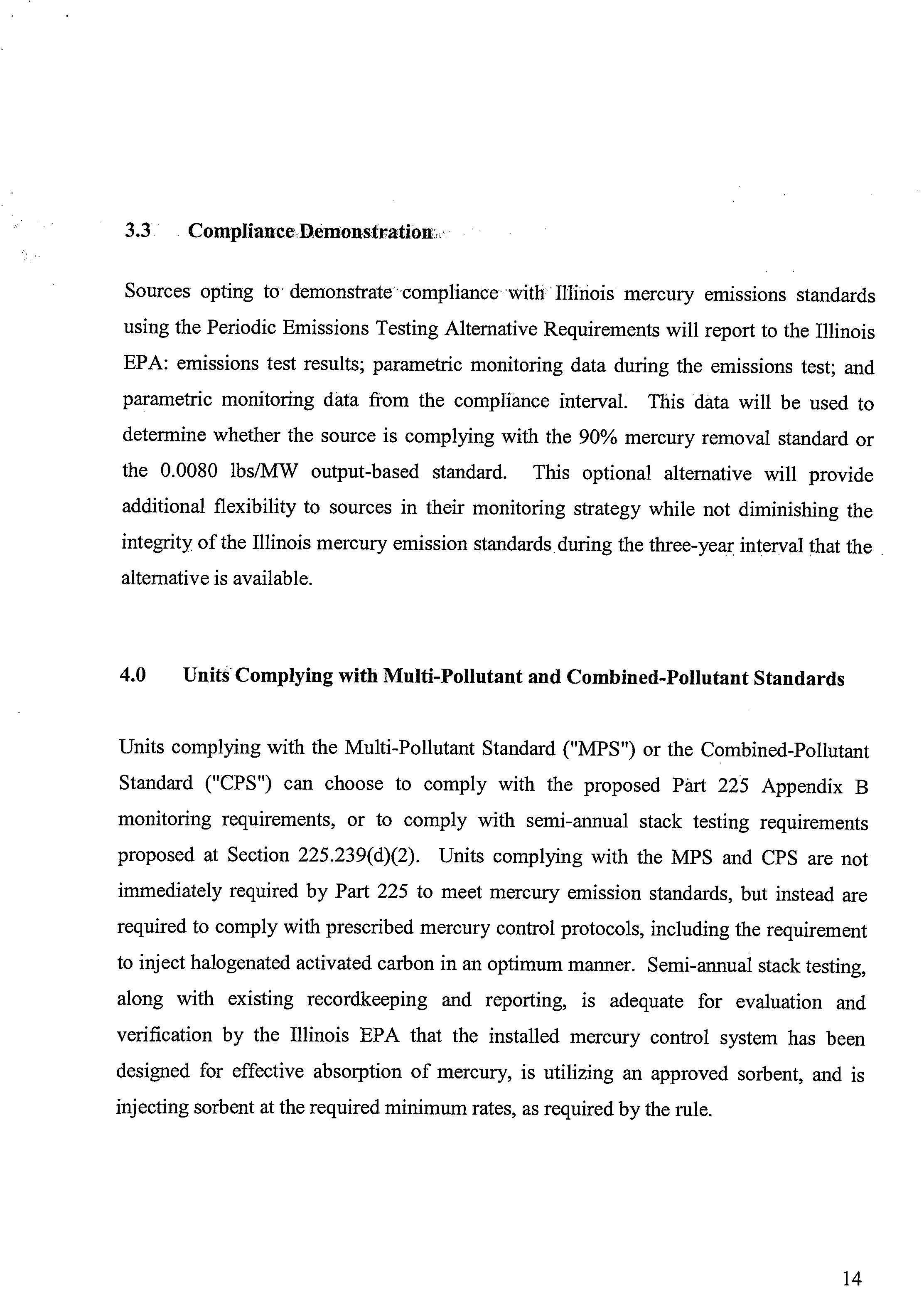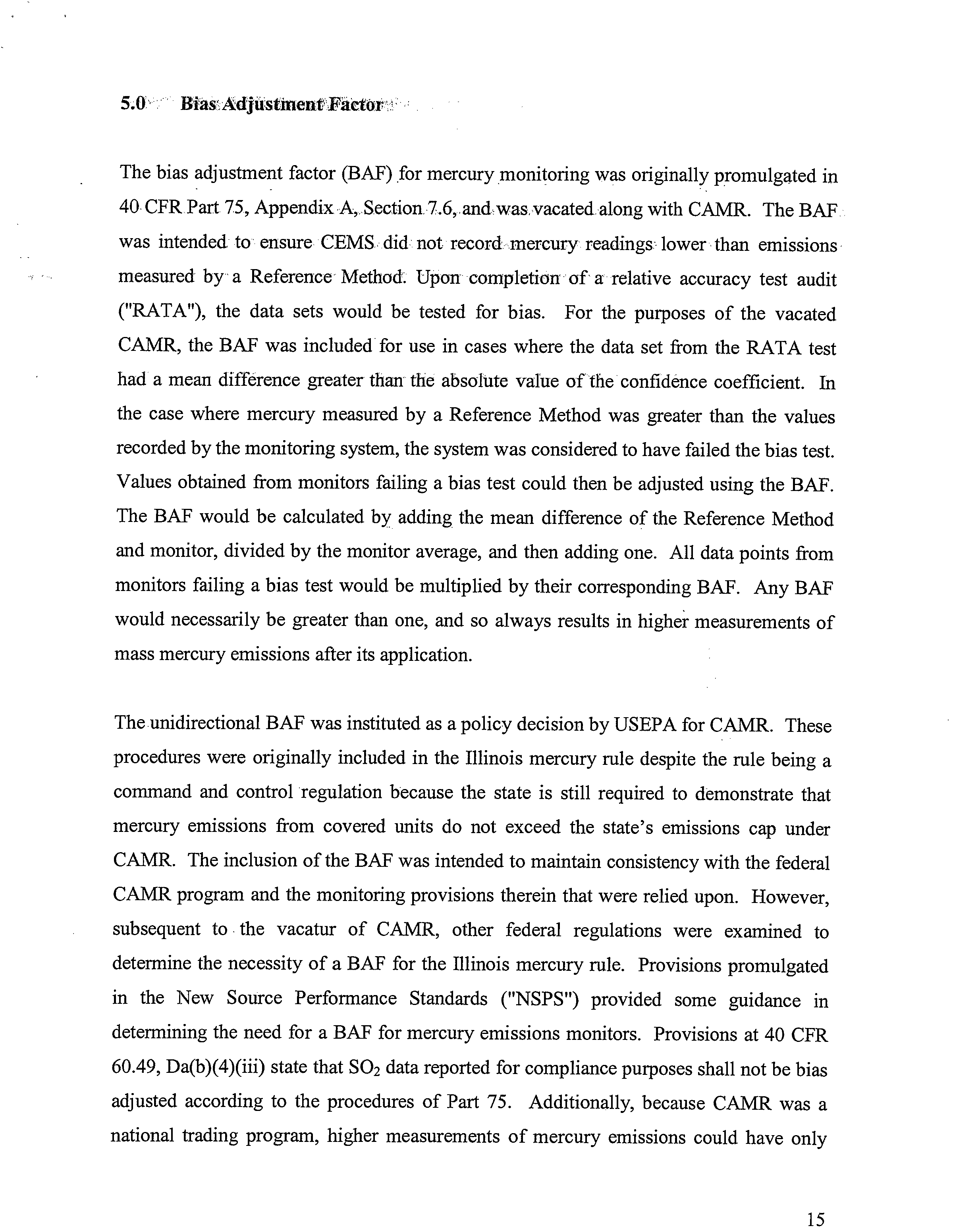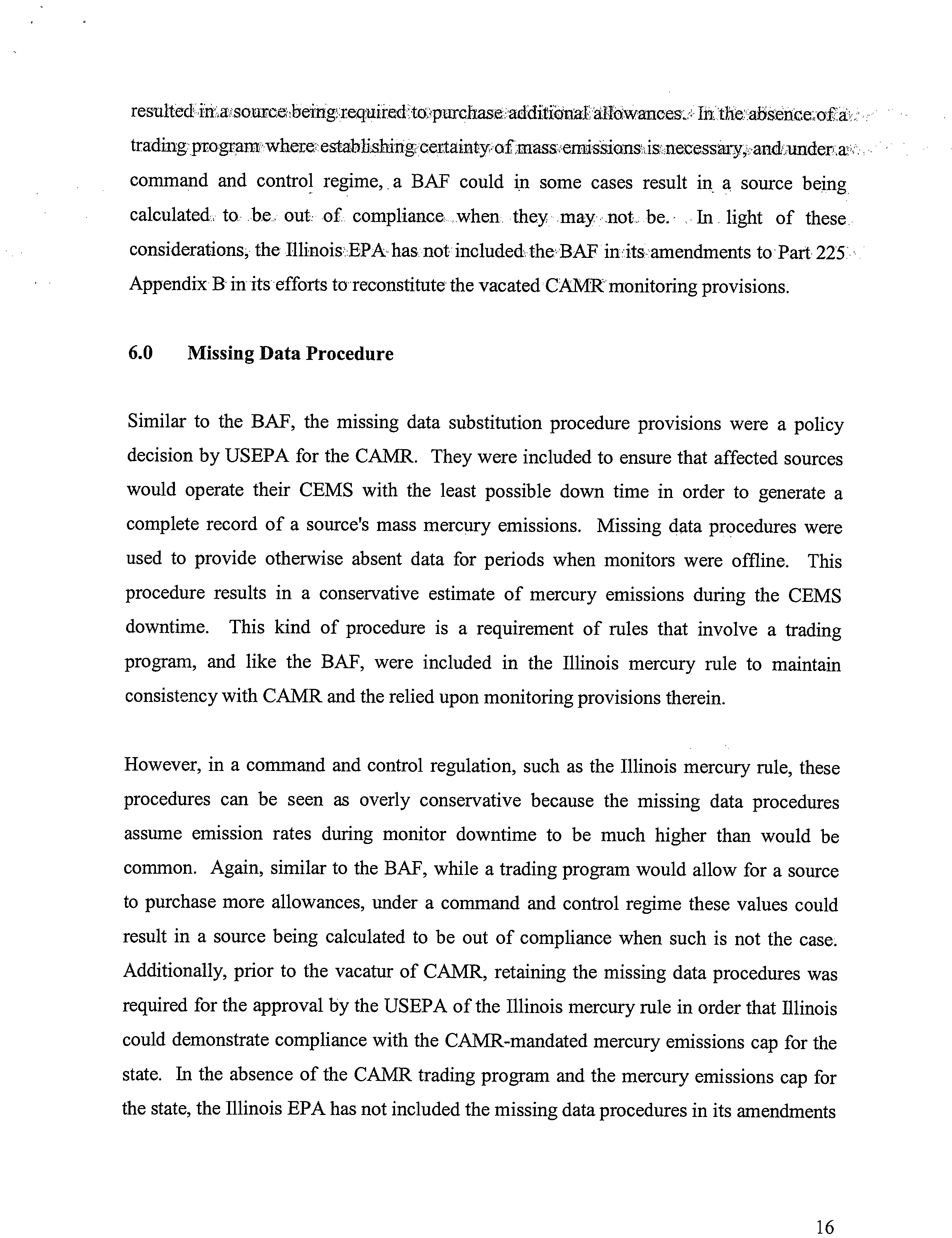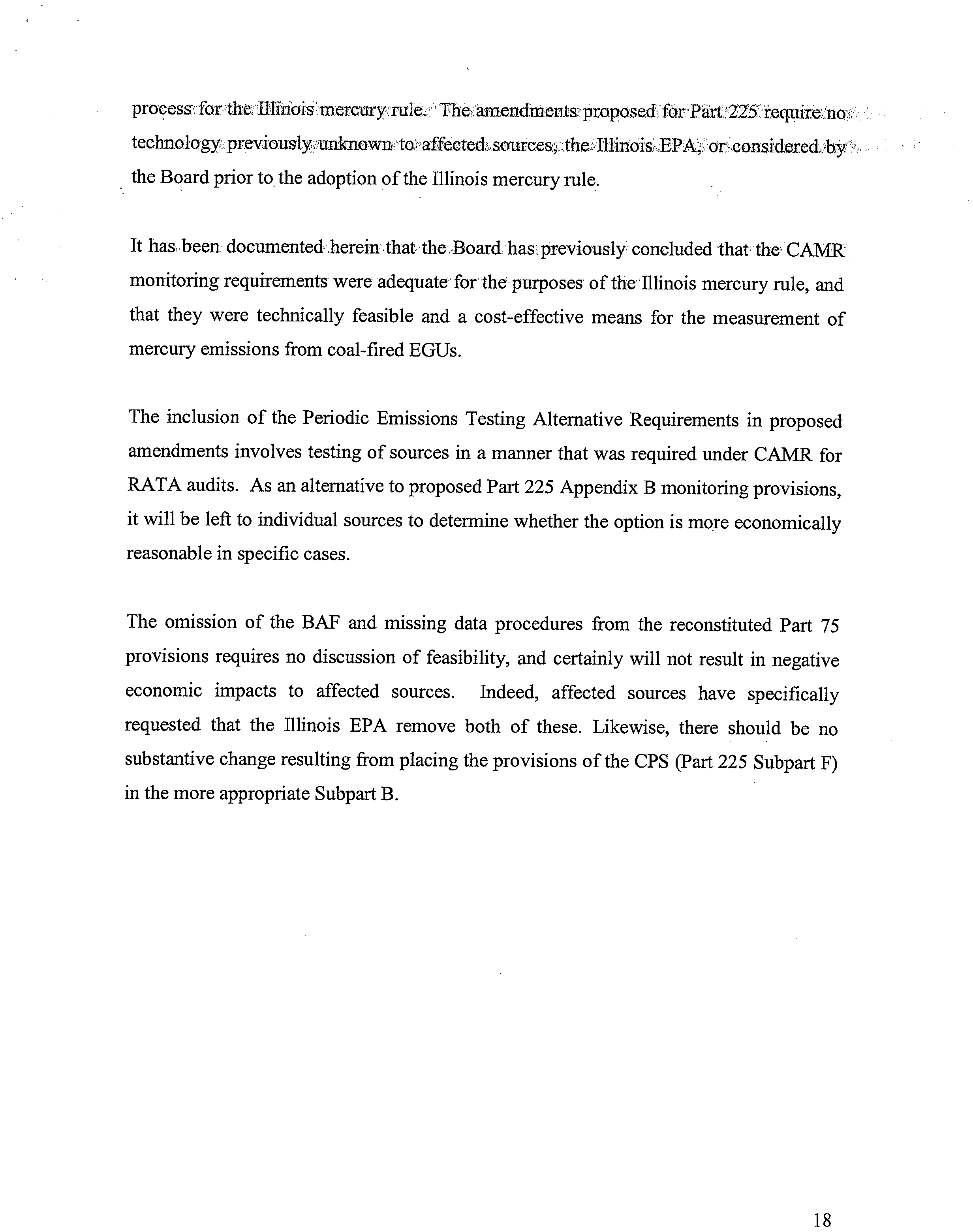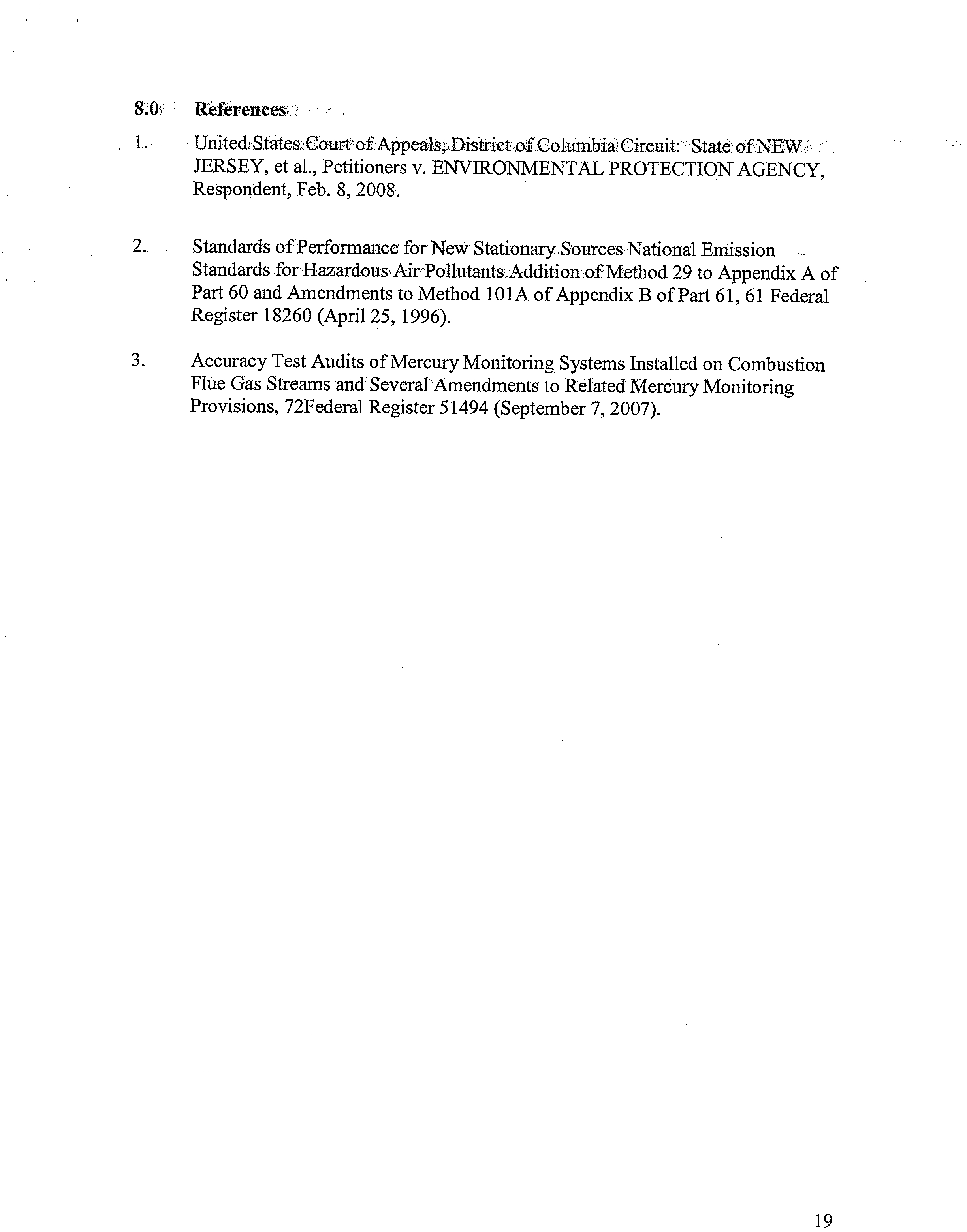L.ERK’S
OFFICE
OCT
0320118
STATE
OF
ILUNOIS
oiIuLlon
Control
Board
TECHNICAL
SUPPORT
DOCUMENT
for
RULE
REVISIONS
TO
PART
225:
ILLINOIS
RULE
FOR;REDUC1NG
MERCURY
EMISSIONS
FROM
COAL-FIRED
ELECTRIC
GENERATING
UNITS
AQPSTR
08-0
1
September
2008
ILLINOIS
ENVIRONMENTAL
PROTECTION
AGENCY
1021
NORTH
GRAND
AVENUE
EAST
P.O.
BOX
19276
SPRINGFIELD,
ILLINOIS
62794-9276
TábièofCiintents
Executive
Summary
2
1.0
Introduction
6
2.0
MercuryMonitoring
Methods
7
2.1
40
CFR
Part
75Methods
for
MonitoringMèrcury
- Feasibility
and
Reasonableness
8
2.2
Support
for
Data
Reporting
10
3.0
Alternative
Stack
Test
Monitoring
11
3.1
Technical
Feasibility
12
3.1.1
Method
29
12
3.1.2
Method
30A
and
Method
30B
13
3.2
Economic
Reasonableness
13
3.3
Compliance
Demonstration
14
4.0
Units
Complying with
Multi-Pollutant
and
Combined-Pollutant
Standards
14
5.0
Bias
Adjustment
Factor
15
6.0
Missing
Data
Procedures
16
7.0
Summary
17
8.0
References
19
1
Executive
S
mary
On February
8,
2008,
the
United
States
Court
of
Appeals
for
the
District
of
Columbia
Circuit
vacated
the
United.
States
EnvironrnentalProtection
Agency
(USEPA),
Clean
Air
Mercury
Rule
(CAMR) This
court
action.
raised
concerns
regarding
the status
of certain
federal
provisions
in 40
CFR
Part
75’(Part75)’dealingwith
the
monitoring
of
mercury
emissions.
Given
the
current
uncertainty
surrounding
federal
mercury
monitoring
provisions,
the
Illinois
Environmental
Protection
Agency
(Illinois
EPA)
has determined
that
a
revision
to the
Iiiinois’mercury
rule
(i.e.,
3’S
IiLAdth.
code
Part
225 Subpart
B)
is
appropriate.
The
primary
focus
of
the
proposed
rule
revisions
will
be
on
the
methods
used
to
measure
mercury
emissions
for the
demonstration
of compliance
with the
emissions
and
control
requirements
and
do
not
include
any revisions
to
the emission
and
control
standards
themselves.
Mercury
monitoring
via a
continuous
emissions
monitoring
system
(CEMS)
will
continue
to be
an
option
for measuring
mercury
emissions.
The
proposed
revisions
also
add
stack
testing
as
an
alternative
method
to monitoring.
This
will
provide
sources
with
flexibility
in their
methods
used
to
measure
mercury
emissions
for
compliance
demonstrations.
Further
proposed
amendments
to
the
rule
include
the
addition
of
an
approved sorbent
for
use
in mercury
control,
reconstituting
the
provisions
of
Part
225
Subpart
F
(i.e.,
Combined
Pollutant
Standard)
into
Part
225
Subpart
B,
and
the
replacement of
specific
citation
to the
Clean
Air
Interstate
Rule
(CAR)
with
citation
to
any
trading
program.
The last
revision
is needed
due to
the
July 11,
2008
vacatur
of
CAR
and
the
uncertainty on what
the
citation
would
be
to any
future
trading
program
for
nitrogen
oxides
(NOx)
and
sulfur
dioxide
(S02)
allowances.
The
Illinois
EPA
considers
these
last
amendments
as
a
“housekeeping”
measures,
and
as
such,
unnecessary
to
address
in
detail
in
this
technical
support
document.
The
primary
purpose
of
this
technical
support
document
is to
demonstrate
that
the
proposed
amendments
to
the
Illinois
mercury
rule
are
both
technically
feasible
and
economically
reasonable.
The
Illinois
EPA
continues
to
support
CEMS
for measuring
2
emissionsafmereuryfroiuelectricgenerating•
comphincewith:thellhinois.mercuryrule.
CEMSweredeenied
by
the
USEPA
tobe
a
technically
feasible
and
economically
reasonable
method
of measuring
mercury
emissions
while
promulgating
CAMR,
and
the
Board
incorporated
these
same
methods
intothe
Illinois
mercuryrule.
This
determinationhad
nobearing
on
the
vacatur
of
CAMR,
and
vice
versa,
and
the
technical
supportregardirrg
CEMS
remains
valid.
The
Illinois
EPA
has
received
assurances
from
USEPA
of
their
support
for
such
an
approach,
as
well
as assurances
that
the
level
of
support
given
to
state
agencies
for
mercury
monitoring
provisions
will
be
equal
to
that
which
was
intended
fOr
monitoring
under
CAMR.
Previously,
the
Illinois
mercury
rule
incorporated
Part
75
by
reference.
The
proposed
amendments
include
the
appropriate
provisions
of
Part
75
monitoring
requirements,
with
noted changes.
Such
changes
include
the
removal
of
provisions
that
were
appropriate
only with
the
existence
of
a national
mercury
trading
program
and
a state-by-state
emissions
cap
(e.g.,
bias
adjustment
factor,
missing
data
substitution).
The
proposed
stack
testing
alternative
is
a
technically
feasible
method
for
the
measurement
of
mercury
emissions,
and
in many cases
may
be
a
lower
cost
option
for
mercury
measurement
than
CEMS.
Stack
testing
provides
a measure
of
flexibility
and
certainty
for
sources
in
demonstrating
compliance.
This
additional
flexibility
is
also
appropriate
as
Illinois
is
no
longer
required
to
demonstrate
compliance
with
a mercury
emissions
cap
for
purposes
of CAMR.
The
Illinois
EPA
has
broad
historic
knowledge
and
experience
with
the
use
of
stack
testing
for
emissions
measurement
and
compliance
demonstrations.
Quarterly
stack
testing,
along
with
the
monitoring
of
source
operating
parameters,
will
provide
sources
an
alternative
to
CEMS
monitoring
of
mercury
emissions
for
a
three-year
period.
The
Illinois
EPA
anticipates
that
during
this
three-year
window
new
federal
regulations
will
prescribe
monitoring
provisions
for
mercury
emissions
and
that
the
Illinois
EPA
will
either
adopt,
or otherwise
allow
the
use
of
those
provisions
to
demonstrate
compliance
with
the
Illinois
mercury
rule
going
forward.
3
The
IIlIneis:
mercuryl
ieicludesa1istoiappmved’sorbent:manafhcturers
whose:
level
of
mercury
control
as•
of
the
time
of
the
rulemaking
process.
The
rule
also
allows
the
use
of,any
other
halogenated
activated
carbon
or
-sorbent
that
has
demonstrated
similar
or
better
effectiveness
for
control
ofmercury
emissions.
Since
that
promulgation
of
the
Illinois
mercury
rule,
and-prior
to
the’
compliance
date
of
the
rule,
Calgon
Carbon
has
demonstrated
to the
Illinois
EPA
that
one
of
their
sorbents
contains
a
similar
or
better
level
of control
in
comparison
to
the
approved sorbents.
As a
result,
it
is
proposed
that
Calgon
Carbon’s FLEAC
MC
Plus
be included
as an
approved
sorbent
for
mercury
control.
The
Combined
Pollutant
Standard
(CPS)
was
negotiated
between
the
Illinois
EPA
and
Midwest
Generation during
the
original
mercury rulemaking
process.
Similar
to
the
Multi-Pollutant
Standard
of
the
mercury
rule,
the
CPS
allows
flexibility
in
complying
with the mercury
provisions
in
exchange
for S02
reductions,
NOx
reductions,
and
other
considerations
agreed to
by the
parties.
The
desire
at
the
time
was
to include
the
CPS
in
the
Illinois
mercury rule,
however,
the
rule
was
in
the
final
stages
of
adoption
and
therefore
it
was
inappropriate
at that
time
to reopen
the
rule
for
inclusion
of
the
CPS.
The
CPS
was
subsequently
included
in
Illinois’
CAIR.
Consistent
with
the
original
desire
and
determination
that
the
more
appropriate
place
for
the
CPS
was
in
the
Illinois
mercury
rule,
the
CPS
will
now
be
removed
from
CAR
and
included
in
the
Illinois
mercury
rule.
Note
that
Midwest
Generation
has
submitted
a
letter
of
intent
to
comply
with
the
CPS,
which are
once
in,
always
in provisions.
Both
the
multi-pollutant
standard
(MPS)
and
the
CPS
contain
restrictions
and
other
provisions regarding
NOx
and
S02
allowances.
Such
allowances
were
expected
to be
issued
as
part
of
the
CAIR.
As
a
result
of
the
July
11,
2008
vacatur
of CAIR,
there
now
exists
uncertainty regarding
what
program
such
allowances
would
originate
from.
As
a
result,
a
proposed revision
is
being
made
to
replace
the
current
citation
to
CAR
allowances
in the
MPS
and
CPS
with
citation
to allowances from
any
trading
program.
4
In:surnTnary,.
thisinercurynIe
are;appropriate.
in
light
ofthe
vacatur
of
.CAMR
The.propos.ed.revisionsarefocused:om.the.rnethods
allowed
to
measure
mercury
emissions
for
demonstration
of
compliance.
The proposed
revisions
do
not
include
any change.
to.
the
emissions.
and
control.
requirements
for mercury
emissions
and
therefore
the level
of mercury
control.
required
by
the
rule
is
not affected.
Aside
from
providing
additional
flexibility
to
sources
for
compliance
purposes,
these
proposed
amendments
represent
little
substantive
change
from the
implementation
of the Illinois
mercury
rule
prior
to the vacatur
of CAMR.
5
Jiitrodiictioi
On
February
8,
2008,
the
United
States Court
of
Appeals
for
the
District
of
Columbia
Circuit
vacated
the
United
States
EnvironmentaiProteetionAgency’s
(“USEPA”)
Clean
Air
Mercury
Rule
(“CAMR”).
This
court
action
effectively,
eliminated
certain
federal
provisions
in
40
CFR
Part
7’
(“Part
75”)
dealing
with
the
mercury
monitoring
that
were
relied
upon
by
Illinois
EPA
in the
rulemaking
(R06-25) for
the
Illinois
mercury
rule.
The
amendments
now
being
proposed
will
replace
the
relied-upon
federal
monitoring
references with
appropriate
monitoring
provisions
for
the
Illinois
mercury
rule
in
the
absence
of
the
vacated
CAMR
program
by
incorporating
the
sections
of Part
75
that
were
previously
relied
upon.
In efforts to ensure
adequate mercury
monitoring
provisions
in the
Illinois
mercury
rule,
Illinois
EPA
has
considered
the
two
monitoring
methods
prescribed
by
40 CFR
Part
75
prior
to
the
vacatur
of
CAMR,
as well
as
a
number
of reference
methods
for
measuring
mercury
approved
by
the
USEPA.
The
monitoring
methods
prescribed
by
Part
75,
CEMS monitors
or
Appendix
K
sorbent
trap
methods,
remain
the
preferred
method
for
the
measurement
of
mercury
emissions
from
EGUs,
as they
provide
accurate
data
on
the
mass
emissions
of
mercury
from
a source
over
a
given
timeframe.
However,
in
order
to
provide greater
flexibility
to
sources
in
demonstrating
compliance
with
Illinois
mercury
emission standards, Illinois
EPA
has
included
another
option
in its
proposed
revisions
to
the
Illinois
mercury
rule.
This
option
provides
an
alternative
stack
testing
provision
that
would
allow
for
quarterly
stack
testing
of
sources
using
approved
reference
methods,
along
with
monitoring
source
operating
parameters
that
could
affect
emissions
from
the
source
while
mercury
emissions
are
not
being
measured.
These
approved
reference
methods include
the
Ontario
Hydro
Method,
EPA
Method
29,
Method 30A,
and
Method
30B.
The
methods
that
were
previously
prescribed
by
Part
75
for
the
vacated
CAMR
are
technically
feasible and
economically
reasonable
methods
for
demonstrating
compliance
with
the
Illinois mercury
emission
standards.
The
federal
mercury
rule
was
vacated
6
because:
a;tr.athng.program:-
.was
thedecidiiig:court,
and:notdüeto::
cost:.
or
feasibiiity.
concernsforthe
monitoring;
requirements.
The
research
done
by
the
USEPA
regarding the cost
and
feasibility
of
mercury
monitoring
is valid
and
has,
been
considered by the
Board
in
its
previous
rulemaking
for the
Illinois
mercury
rule.
In
addition, the proposed
reference
methods
for
the
measurement
of
mercury
are
valid
methods
for determining
compliance
with
Illinois
mercury
emission
standards
in
the
absence
of
a federal
trading
program
and
a
statewide
mercury
emission
cap.
These
proposed
methods
have
also
been
shown
to be
technically
feasible,
and in
many
cases
may provide
a lower
cost
option
for
sources
in
comparison
to
the previously
referenced
Part
75
methods.
In
such
cases
where
the alternative
stack
testing
provisions
can
provide
sources
with
a lower
cost
option
for
compliance
demonstration,
it
is
apparent
that
this
alternative would
be
considered
economically
reasonable.
Affected
sources
may
determine which
method
of
emissions
determination
will
best
address
their
particular
situations.
Additional proposed
revisions
addressed
by
this
document
will
result
in
either
no cost
impact
to
sources
or
in
lower
compliance
and
administrative
costs
to
sources.
These
issues,
such
as revisions
regarding
the
bias
adjustment
factor
and
missing
data
procedures, require
no
discussion
regarding
technical
feasibility.
They
are
addressed
in
this
document
in
order
to demonstrate
that
the
integrity
of
the
adopted
Illinois
mercury
emission
standards
is
not diminished
by
the
proposed
revisions.
2.0
Mercury
Monitoring
Methods
Illinois
EPA
has
proposed
amendments
to Part
225
to
reconstitute
the monitoring
provisions
formerly
codified
at 40
CFR
Part
75
prior
to
the
vacatur
of CAMR.
These
monitoring provisions
have
been
proposed
by
the
Illinois
EPA
as
amendments
to
the
Illinois
mercury rule at
35
Ill.
Adm.
Code
Part
225,
Appendix
B and
we
have
consulted
USEPA
regarding
these
revisions.
7
2.1
.40.
CFR
‘Part.
75.
Methods,
fur
MO.nioriUg
Méruury::
-
Féasihilit..
and
ReasonabIeness
The
methods
for
monitoring
mercury
from
EGUs
that
were
considered
in
the
initial
mercury
rulemaking
remain
valid,
technically
feasible,
and
economically
reasonable.
These
methods
include
mercury
CEMS
and
Appendix
K
sorbent
trap
methods.
The
amendments
to the
Illinois
mercury
rule
have
been
proposed
in
order
to
reconstitute
the
monitoring provisions
of
CAMR,
found
at
40
CFR
Part
75,
following
the
vacatur
of
all
of
CAMR.
These
vacated
monitoring
provisions
of
CAMR
that
have
been
proposed
as
amendments
to
the
Illinois
mercury
rule
remain
technically
feasible
and
economically
reasonable
as
CAIVIR
was
not
vacated
due
to
concerns
regarding
the
cost
or feasibility
of
monitoring.
The
costs
and
feasibility
of
monitoring
were
researched
and
considered
by
USEPA prior
to
the
promulgation
of CAMR
and
found
to be
both
reasonable
and
feasible.
In addition,
the
costs
and
feasibility
of
mercury
monitoring
was
previously
considered
by
the
Illinois
Pollution
Control
Board
(“Board”)
during
the
initial
Illinois
mercury rule
rulemaking
and
found
to be
both
reasonable
and
feasible.
According
to
vendors
of
mercury
monitoring
systems,
the
great
majority
of
sources
formerly
affected
by
CAMR have
already
purchased
monitoring
equipment
that
would
have
been
compliant with
the
vacated
portions
of
Part
75
in question.
As
previously
stated, on
February
8,
2008,
when
the
United
States
Court
of Appeals
for
the
District
of
Columbia
Circuit
vacated
CAMR,
the
court
ruled
that
CAMR,
a trading
program
under
Section
111
of
the
Clean
Air
Act
(“CAA”),
as
adopted,
inconsistent
with
provisions of
the
Clean Air
Act.
USEPA
had
previously
concluded
that
it was
appropriate
and
necessary
to
regulate
mercury
emissions
from
coal-fired
EGUs
under
section
112
of the
CAA,
and
these
EGUs
were
then
listed
as
sources
of
hazardous
air
pollutants (“HAPs”)
regulated
under
that
section.
In response
to
petitioners
in
the
aforementioned
court
of
appeals,
the
court
stated:
‘Because coal-fired
EGUs
are
listed
sources
under
section
112,
regulation
of
existing
coal-fired
EGUs’
mercury
emissions
under
section
111
is prohibited
effectively
invalidating
CAMR
‘s
regulatory
approach.”
8
And
that:
“Pet
itionerscontend.
thatoncetheAdministrator’determined
in
2000
that
EGUs should
be
regulated
under
Section
112
and
listed
them
under
section
112c)(1),.
EPA had
no
authority
to delist
them
without
taking
the
steps
required
under
section.
11
2
(’cX9,)..
We
agree.
The
vacatur
CAMR
on
theground&.of
USEPA”regulatory
approach,
does
not
invalidate
the
technical
and
economic
assessments
that
were
conducted
regarding
mercury
monitoring.
The
.cost
and
feasibility
of
Part
75
monitoring
systems
were
also
considered
by
the
Board
in
the
initial
Part
225
rulemaking
for
mercury
emissions
from
coal-fired
EGUs.
Following
testimony
questioning
the
reliability
of
CEMS
for
mercury monitoring
or
the
availability
of
reliable
CEMS
for
monitoring
the
Board
concluded:
“While
Mr.
McRanie
testified
about
problems
with
CEMS, contrasting
evidence
includes
the
USEPA
‘s decision
to
adopt
the
Part
75
monitoring
requirements
and
evidence
that
contradicts
some
of
Mr.
McRanie
testimony.
Based
on
the
evidence
in
the
record
the
Board
finds
that
merculy
monitoring
technology
is
technologically
feasible.
The
Board
also
finds
that
the
technology
is
currently
available.”
(p.
41
of Board’s
Nov.
2,
2006, Second
Notice
Opinion and
Order)
The
economic
impact to
sources
was
also
considered,
by
the
Board
in
the
same
opinion
and
order
quoted
above,
and
was
found
to
be
reasonable
when
weighed
against
the
benefits
of
the
mercury emission
reductions.
“The
Board
fully
recognizes
that
the
Agency
proposal
will
result
in
costs
for
Illinois
EGUs
and
that
those
costs
will
exceed
those
required
by
implementation
of
CAMR. Nonetheless,
the
Board
noted
above
that,
compared
with
CAMR, the
Agency
‘s
proposal
reduces
mercury
emissions
more
quickly and
more
deeply
than
CAMR.
The
Board concluded
above
on
the
basis
of
the
record
in
this
proceeding
that
the
proposed
rule
can
be
expected
to
result
in reduction
of
mercury
deposition
and
to
benefit
the
public health in
the
state.
Therefore,
the
Board
finds
that
when
the
Agency ‘.s’
estimated
compliance
costs
are
weighed
against
the
expected
benefits,
the
proposed
rule
that
the
Board
adopts
today
is
economically
reasonable.”
(p.
78
of
Board’s
Nov.
2,
2006,
Second
Notice
Opinion
and
Order)
9
It
should
be
.noted\:that
illinois
EPA.
ha
proposed:additidnaf
amendments
toprovide..a
greater
degreeof flexibility
and
potentially lower.
cost:inrnercury
monitoring,
specifically
the
Periodic
Emissions
Testing
Alternative
Requirements.
This
additional flexibility
is
appropriate
as the
state
is.
no
longer
required
to
demonstrate
compliance
with
a
mercury
emissions
cap
for
EGUs
in accordance
with
CAMR.
Finally,
Illinois
EPA
is
aware, through
discussion
with
vendors
of
mercury
monitoring
systems
and
USEPA, that
the
great
majority
of
coal-fired
EGUs
originally
affected
by
CAMR
have
already
purchased
monitoring
systems compliant
with
Part
75
requirements
in
anticipation
of
the
January
1,
2009
effective
date
of
the now
vacated
CAMR.
This
suggests
that
reliable
monitors
are
indeed
available
at a
reasonable
cost.
It
should
also
be
noted
that
the
effective
date
for
the
amended
monitoring
provisions
proposed
has
been
changed
to
July
1,
2009,
providing
additional
time
and
flexibility
to
sources
that
may
be
needed
due
to
any
uncertainty
caused
by the
vacatur
of
CAMR.
2.2
Compliance
Demonstration
In anticipation
of
the
January 1,
2009
effective
date
of
CAMR,
significant
technical
infrastructure
was
created
by USEPA
to
accept
data
from
CEMS
units,
perform
quality
assurance and
quality
control
(“QAIQC”)
on
the
reported
data,
and
to
report
that
data
to
the
states.
USEPA has
assured states,
and
the
Illinois
EPA
in
particular,
that
support
in
this
regard
will
be
available
to
states
with
individual
state
rules
at a
level
equal
to
that
which
would
have
been
provided
under
CAMR.
Although
USEPA
fully
expects
to
provide
the
desired
level
of support,
it
should
be
noted
that
USEPA
has
also
expressed
some
concern in
regards
to their
legal
authority
to
accept
electronic
monitoring
data
in
light
of
the
CAMR
vacatur,
thereby
causing
some
uncertainty
in
this
area.
In
the
event
that
USEPA
will
not
be able
to accept
electronic
monitoring
data
and
perform
the
associated
QAIQC,
USEPA has
confirmed
that
identical
support
services
will
be
available to
Illinois
EPA
and
other
state
agencies
through
the
supplying
vendor
(i.e.,
Perrin
Quarles
Associates,
Inc.)
on
a contracted
basis
utilizing
the
same
software
and
infrastructure
that
USEPA
plans
to
use
and
that
was
developed
in
anticipation
of
CAMR.
10
The.
proposedrevisñms
theref&e:
require
that.
CEMS.dàta:b..reported.toUSBPA..or
the
Illinoi&
.EPMs designee
besubject•.toQAiQC.procedures,.and
then
reported
to
the
Illinois
EPA
to
verify
compliance
with
Illinois
mercury
standards.
All
necessary
efforts
have.been
made.bythe
Illinois
EPA
in proposed
revisions
te.the
Illinois
mercury
rule
and
in
consultation.
with
USEPA
to,
ensure
that
reporting
protocols
will
be
consistent
with
those
anticipated
under
CAMR
fOr
sources
utilizing
CEMS
monitoring
and
reporting.
However,
if
unforeseen
circumstances
cause
USEPA
and
the
planned
designee
to
both
be
unable
to
receive
mercury
monitoring
data
in
the
proper
format,
the
proposed
rule
modifications
include
provisions
allOwing
the
illinois
EPA
to
specify
a different
format
for
data
reporting,
thus
giving
additional
flexibility
to
sources
while
ensuring
that
Illinois
EPA
receives
the
necessary
data.
3.0
Alternative
Emissions
Testing
Illinois
EPA
has
included
in
its
proposed
amendments
to
the
Illinois
mercury
rule
provisions
for
an
alternative
monitoring
plan
requiring
quarterly
emissions
testing
of
sources
in
lieu
of the
proposed
reconstituted
Part
75
monitoring
requirements.
These
emissions
testing
provisions
provide
sources
an
alternative
method
for
demonstrating
compliance
with
Illinois
mercury
emission
standards
while
still
ensuring
a
high
level
of
integrity
in
regards to
compliance
verification.
The
Illinois
EPA
has
extensive
knowledge
and
experience
with
the
utilization
of
stack
testing
for
compliance
demonstrations.
The
Periodic
Emissions
Testing
Alternative
Requirements,
proposed
as
amendments
at
35
Ill.
Adm.
Code
Section
225.239,
can
be
performed
using
approved
USEPA
methods
for
measuring
mercury
in
an
emissions
test
of
a coal-fired
EGU,
and
so
are
technically
feasible.
The emissions
test
alternative
may
also
provide
a
lower
cost
option
for
sources relative
to
the
reconstituted
Part
75
monitoring
requirements,
and
so
are
considered
to
be
economically
reasonable
as
an
alternative
monitoring
measure.
Affected
sources
may
determine
which
method
of
emissions
determination
will
best
address
their
particular
situations.
11
3.1:
TëthniaIFasibiHty
Emissions
tests
performed
to
demonstrate compliance,
with
the
Illinois
mercury,
emission,
standards
can
be
conducted
using
one
of
three..approved
test
methods.
These
methods
are
the
Ontario Hydro
Method
and
EPA’
Methods
‘29,
30A,
and.
30B. The
emissions
test
methods
were
approved
by
USEPA
fOr’
initial”
certifiäation
and
relative
accuracy
test
audits
(“RATA”)
of
Part
75
monitoring
equipment,
and
are
considered
to
be
accurate
methods
for
the
measurement
of
mercury
from
coal-fired
EGU stacks.
Emissions
tests
are
to
be
conducted’
while monitoring
source
operational
parameters
to
ensure
that
measurements
accurately
represent
mercury
emissions
for
the
time interval
that
the
test
will
be
used to
demonstrate
compliance.
These
operational
parameters
will
be
submitted
to
Illinois
EPA
in
a
Continuous
Parameter
Monitoring
Plan
prior
to
the
test
as
prescribed
in
the
proposed
amendments
at
Section
225.239(f)(4),
The
sourcemust
then
continue
to
monitor
these
same
parameters
and operate
the
EGU
in
a
manner
consistent
with
the
Continuous Parameter
Monitoring
Plan
for
the
duration
of
the
compliance
interval.
This
will
ensure that
the
source
continues
to
operate
consistent
with
the
operational
conditions
under
which compliance
was
demonstrated,
thus
providing
assurance
that
the
source
maintains
ongoing
compliance.
3.1.1
Method
29
Method
29, “Determination
of
Metals
Emissions
from
Stationary
Sources”
is
an
EPA
Method
for
determining
antimony
(Sb), arsenic
(As),
barium
(Ba),
beryllium(Be),
cadmium
(Cd),
chromium
(Cr), cobalt
(Co),
copper
(Cu),
lead
(Pb), manganese
(Mn),
mercury
(Hg),
nickel
(Ni),
phosphorus
(P),
selenium
(Se),
silver
(Ag), thallium
(Ti),
and
zinc
(Zn) emissions
from
stationary
sources.
It
has
been
an
approved
method
for
measuring
metal
emissions
from stationary
sources
since
19962,
and
is
codified
at
40
CFR Part
60
Appendix
A
(incorporated
by
reference
in
Section
225.140).
12
3.L2.
30W:
In
response
to
comments
to
USEPA
3
objecting
to
the
Ontario
Hydro
Method
being
used
for
RATA.
tests
of
mercury
monitors,
USEPA
approved
two
alternative
methods
for
measuring
mercury
in
astacktest
of
a stationarysource.
These:two
methods
are
Method,
30A,
“Determination
of
Total
Vapor
Phase
Mercury
Emissions
from
Stationary
Sources
(Instrumental
Analyzer
Procedure)”
3
and
Method
30B,
“Use
of
Sorbent
Traps
to
Measure
Total
Vapor Phase
Mercury
Emissions
from
Coal-Fired
Combustion
Sources”
4
.
These
two
methods
were
approved
as
alternatives
because
both
the
Ontarib
Hydrb
Method
and
Method
29
are
wet
chemistry
methods,
and
the
Ontario
Hydro
Method
is considered
to
be
accurate,
but
complex.
Both
methods,
30A
and
30B,
were
approved
by
the
USEPA
for
the
measurement
of
mercury
emissions
from
stationary
source
in
2007,
and
are
codified
at
40
CFR
Part
60
Appendix
A-8
(incorporated
by
reference
in
Section
225..
140).
3.2
Economic
Reasonableness
The
Periodic
Emissions
Testing
Alternative
Requirements
have
been
proposed
as
amendments
to
the
Illinois
mercury rule
in
order
to
provide
an
alternative
to
mass
emissions
monitoring
methods previously
required
by
Part
75,
and
are
now
proposed
as
amendments
in
Part
225
Appendix
B.
The
alternative
emissions
testing
provisions
may
be
a
lower
cost
option
to
sources
for
the
three
year
interval
for
which
they
are
proposed,
and
may
provide
additional
flexibility
in demonstrating
compliance
with
Illinois
mercury
emission
standards
while
transitioning
to new
monitoring
equipment
and
requirements.
For
these
reasons,
and
because
it is
an
additional
option
for
monitoring
and
compliance
demonstration,
it
is
considered
to
be
an
economically
reasonable
addition
to
the
Illinois
mercury
rule
without
consideration
of
specific
cost
estimates
for
emissions
testing..
Notwithstanding,
the
Illinois
EPA
in
consultation
with
several
source
emission
testing
companies,
estimates
an
average
cost
of
approximately
$50,000
per
test.
For
many
Illinois
sources,
emissions
testing
on
a
quarterly
or
semi-annual
basis
may
prove
to
be
comparable
in
cost
or
lower
in
cost
to
proposed
Part
225
Appendix
B
monitoring
requirements.
As
noted earlier,
affected
sources
may
detennine
which
method
of
emissions
determination
will
best
address
their
particular
situations.
13
3.3
CornplianceDemonstration..
Sources
opting
to demonstratecompliance”
with
Illinois
mercury
emissions
standards
using
the
Periodic
Emissions
Testing
Alternative
Requirements
will
report
to
the
Illinois
EPA:
emissions
test
results;
parametric
monitoring
data
during
the
emissions
test;
and
parametric
monitoring
data
from
the
compliance
interval.
This
data
will
be used
to
determine
whether
the
source
is
complying
with
the
90%
mercury
removal
standard
or
the
0.0080
lbs/MW
output-based
standard.
This
optional
alternative
will
provide
additional
flexibility to
sources
in their
monitoring
strategy
while
not
diminishing
the
integrity,
of
the
Illinois
mercury
emission
standards
during
the
three-year
interval
that
the
alternative
is
available.
4.0
Units
Complying
with
Multi-Pollutant
and
Combined-Pollutant
Standards
Units
complying
with
the
Multi-Pollutant
Standard
(“MPS”)
or
the
Combined-Pollutant
Standard
(“CPS”) can
choose to
comply
with
the
proposed
Part
225
Appendix
B
monitoring requirements,
or
to
comply
with
semi-annual
stack
testing
requirements
proposed
at
Section 225.239(d)(2).
Units
complying
with
the
MPS
and
CPS
are
not
immediately required
by Part
225
to meet
mercury
emission
standards,
but
instead
are
required
to
comply
with
prescribed
mercury
control
protocols,
including
the
requirement
to
inject
halogenated
activated
carbon
in
an
optimum
manner.
Semi-annual
stack
testing,
along
with
existing recordkeeping
and
reporting,
is
adequate
for
evaluation
and
verification by
the
Illinois
EPA
that
the
installed
mercury
control
system
has
been
designed
for
effective
absorption
of mercury,
is
utilizing
an
approved
sorbent,
and
is
injecting sorbent
at
the
required
minimum
rates,
as
required
by
the
rule.
14
5.0*
BiasAdjü:stinentFaetor.
V
The
bias
adjustment
factor
(BAF)
for
mercury
monitoring
was
originally
promulgated
in
40
CFR
Part
75, Appendix.
A,.
Section.7.6,andwas.vacatedalong
with
CAMR.
The
BAF
was
intended
to
ensure
CEMS
did not
record
mercury
readings
lower
than
emissions
measured
by
V
a
Reference
Method.
Upon
completion
of
a
relative
accuracy
test
audit
(“RATA”),
the
data
sets
would
be
tested
for
bias.
For
the
purposes
of
the
vacated
CAMR,
the
BAF
was
included
for
use
in
cases
where
the
data
set
from
the
RATA
test
had
a
mean
difference
greater
than
the
absolute
value
of the
confidence
coefficient.
In
the
case
where
mercury
measured
by
a Reference
Method
was
greater
than
the
values
recorded
by
the
monitoring
system,
the system
was
considered
to have
failed
the bias
test.
Values
obtained
from
monitors
failing
a bias
test
could
then
be adjusted
using
the BAF.
The
BAF
would
be
calculated
by adding
the mean
difference
of
the Reference
Method
and
monitor, divided
by
the
monitor
average,
and
then
adding
one.
All
data
points
from
monitors
failing
a
bias
test
would
be
multiplied
by
their
corresponding
BAF.
Any
BAF
would
necessarily
be
greater
than
one,
and
so
always
results
in
higher
measurements
of
mass
mercury
emissions after
its
application.
The
unidirectional
BAF
was
instituted
as a
policy
decision
by
USEPA
for
CAMR.
These
procedures were
originally
included
in
the
Illinois
mercury
rule
despite
the
rule
being
a
command and
control
regulation
because
the
state
is
still
required
to
demonstrate
that
mercury
emissions
from
covered
units
do
not
exceed
the
state’s
emissions
cap
under
CAMR.
The
inclusion
of
the
BAF
was
intended
to
maintain
consistency
with
the
federal
CAMR
program
and the
monitoring
provisions
therein
that
were
relied
upon.
However,
subsequent
to the
vacatur
of CAMR,
other
federal
regulations
were
examined
to
determine the
necessity
of
a
BAF
for
the
Illinois
mercury
rule.
Provisions
promulgated
in
the
New
Source
Performance
Standards
(“NSPS”)
provided
some
guidance
in
determining the
need
for
a BAF
for
mercury
emissions
monitors.
Provisions
at 40
CFR
60.49,
Da(b)(4)(iii)
state
that
SO
2
data
reported
for
compliance
purposes
shall
not
be bias
adjusted
according
to the
procedures of
Part
75.
Additionally,
because
CAMR
was
a
national
trading
program,
higher
measurements
of
mercury
emissions
could
have
only
15
resulted
lnthe.absnceof,
command
and
control
regime,
a
BAF
could
in
some
cases
result
in
a
source
being
calculated.
to
.be.
out
of
compliance
when
they.
may.
.not.
be.
In
light
of
these
considerations,
the
Illinois.EPA
has
not
included
the
BAF
inits
amendments
to
Part
225
Appendix
B in
its efforts
to
reconstitute
the vacated
CAMR
monitoring
provisions.
6.0
Missing
Data
Procedure
Similar
to the
BAF,
the
missing
data
substitution
procedure
provisions
were
a policy
decision
by
USEPA
for
the
CAMR.
They
were
included
to
ensure
that
affected
sources
would
operate
their
CEMS with
the
least
possible
down
time
in
order
to
generate
a
complete
record
of
a
source’s
mass
mercury
emissions.
Missing
data
procedures
were
used
to
provide
otherwise
absent
data
for
periods
when
monitors
were
offline.
This
procedure
results
in
a
conservative
estimate
of
mercury emissions
during
the
CEMS
downtime.
This
kind
of
procedure
is
a
requirement
of
rules
that
involve
a trading
program,
and
like
the
BAF,
were
included
in
the
Illinois
mercury
rule
to
maintain
consistency
with
CAMR
and
the
relied
upon
monitoring provisions
therein.
However,
in
a command
and
control
regulation,
such
as
the
Illinois
mercury
rule,
these
procedures
can
be
seen
as
overly
conservative
because
the
missing
data
procedures
assume emission
rates
during monitor
downtime
to
be
much
higher
than
would
be
common. Again,
similar
to
the
BAF,
while
a trading
program
would
allow
for
a
source
to
purchase
more
allowances,
under
a command and
control
regime
these
values
could
result
in
a
source
being
calculated
to
be
out
of compliance
when
such
is
not
the
case.
Additionally,
prior
to the
vacatur
of
CAMR,
retaining
the
missing
data
procedures
was
required
for
the
approval
by
the USEPA
of
the
Illinois
mercury
rule
in
order
that
Illinois
could
demonstrate
compliance
with
the
CAMR-mandated
mercury
emissions
cap
for
the
state.
In
the
absence
of the
CAMR
trading
program
and
the
mercury
emissions
cap
for
the
state,
the
Illinois
EPA
has
not
included
the
missing
data
procedures
in
its
amendments
16
to Part
225’ :Appendi
W
ini±s:effoiia.
tc reconstitute
tlWvaeated.
CAMR’:thonitoring:
provisioiis.,.
Also. included
in
proposed
amendmentsto
Part 225 rare;’;provisions
requiring
monitor
availability
for75%
of
any
givenquarter.
This
level.of
availability
has been
found
to
be
achievable
by USEPAand
is
comparable
to
the level
of monitor
availability
for
mercury
monitoring
of
new sources
required
by
40
CFR 60.49Da(p)(4)(i).
This
requirement
does
not
include
periods
of
unavailability
due
to
regular
calibration
of
the monitor.
The
proposed amendments
fOr monitoring
include an
additionaI
degree
of
flexibility
in
this
regard.
In the event
that a
source
monitor may
be unavailable
for
more
than
25% of
a
given
quarter,
the proposed
alternative
stack
test provisions
are an
additional
option
for
sources to
demonstrate
compliance
for
that quarter.
7.0
Summary
In preparing
this
technical
support
document
for the proposed
amendments
to the
Illinois
mercury
rule, the
Illinois EPA
has
sought to
outline significant
changes
that
have
been
made
to
the adopted
rules
and
the
manner
that affected
sources
may
be impacted
by the
proposed
amendments.
As previously
stated,
all
efforts were
made while
drafting
the
proposed
amendments
to
ensure
that sources
that had
been
moving
forward
with
a
monitoring
plan
for
mercury emissions
could
dO
so in a fashion
consistent
with
what
was
required
under
the vacated
CAMR.
This is
evident
in
the
reconstituted
Part
75
monitoring
provisions
included
at Part
225 Appendix
B.
Additionally,
efforts
have
been
made
to mitigate
any
effects
of
the
uncertainty
introduced
by the
vacatur
of
CAMR
over
recent
months.
These
considerations
have
led
to the
postponement
of the
effective
date
on
which
monitoring
will
be
required,
the addition
of alternative
stack
testing
provisions
available
fOr the
first three
years
of monitoring,
and
the omission
of the
BAF
and
missing
data
procedures
from monitoring
protocols.
Much of
the
detailed feasibility
and cost
considerations
and documentation
typically
contained
in
a
technical
support
document
have
been
provided
in the
earlier
rulemaking
17
process;
forthe:iihri&s
mercury
mie.
The
amendments
proposed.
fcrPrt225require:;no
technology.
previously:unknowm
toaffected.sourcesthc: I’llinois.EPA;or::considered.b.
the
Board
prior
to
the
adoption
of
the
Illinois
mercury
rule.
It
has
been
documented
herein
that
the
Board
has
previously:
concluded
that
the
CAMR
monitoring
requirements
were
adequate
for
the
purposes
of
the
Illinois
mercury
rule,
and
that
they
were
technically
feasible
and
a
cost-effective
means
for
the
measurement
of
mercury
emissions
from
coal-fired
EGUs.
The
inclusion
of
the
Periodic
Emissions
Testing
Alternative
Requirements
in
proposed
amendments
involves
testing
of sources
in
a
manner
that
was
required
under
CAMR
for
RATA
audits.
As
an
alternative
to proposed
Part
225
Appendix
B
monitoring
provisions,
it
will
be
left
to individual
sources
to
detennine
whether
the
option
is more
economically
reasonable
in specific
cases.
The
omission
of
the
BAF
and
missing
data
procedures
from
the
reconstituted
Part
75
provisions
requires
no
discussion
of
feasibility,
and
certainly
will
not
result
in
negative
economic
impacts
to
affected
sources.
Indeed,
affected
sources
have
specifically
requested
that
the
Illinois
EPA
remove
both
of
these.
Likewise,
there
should
be
no
substantive
change
resulting
from
placing
the
provisions
of
the
CPS
(Part
225
Subpart
F)
in
the
more
appropriate
Subpart
B.
18
8.0
Refèrences:
1.
UnitedStátes..Courtof.Appeals;.Disrietof.Col.umhia
Circuit:
.StatéofNEW:.
JERSEY,
et
a!.,
Petitioners
v. ENVIRONMENTAL
PROTECTION
AGENCY,
Respondent,
Feb.
8,
2008.
2..
Standards
of
Performance
for
New
Stationary.
Sources
National
Emission
Standards
for
Hazardous
Air
Pollutants,Addition•of
Method
29
to
Appendix
A
of
Part
60
and
Amendments
to
Method lOlA
of
Appendix
B
of
Part
61,
61
Federal
Register
18260
(April
25,
1996).
3.
Accuracy
Test Audits
of
Mercury
Monitoring
Systems
Installed
on
Combustion
Flue
Gas
Streams
and
Several
Amendments
to
Related
Mercury
Monitoring
Provisions,
72Federal
Register
51494
(September
7,
2007).
19
